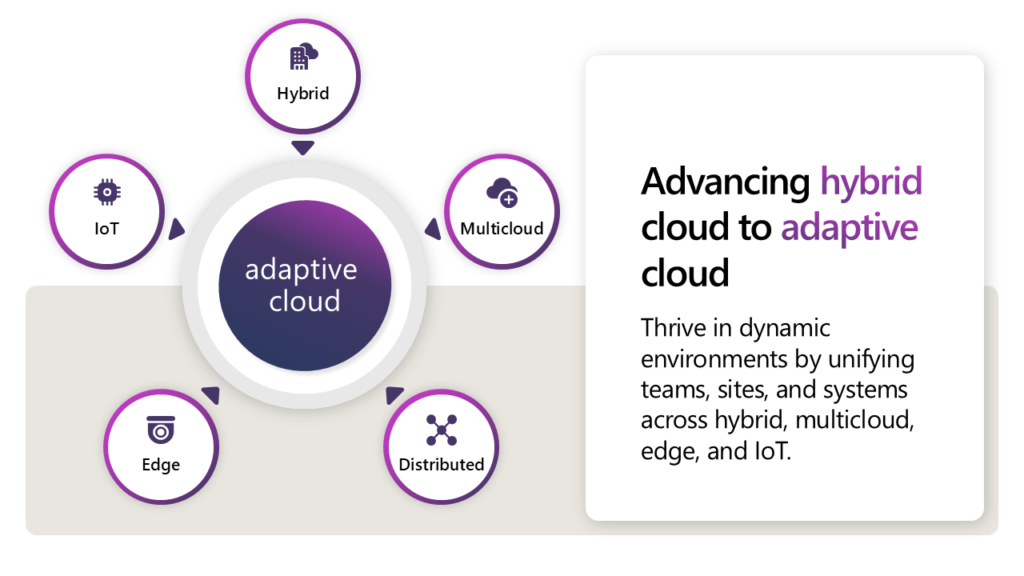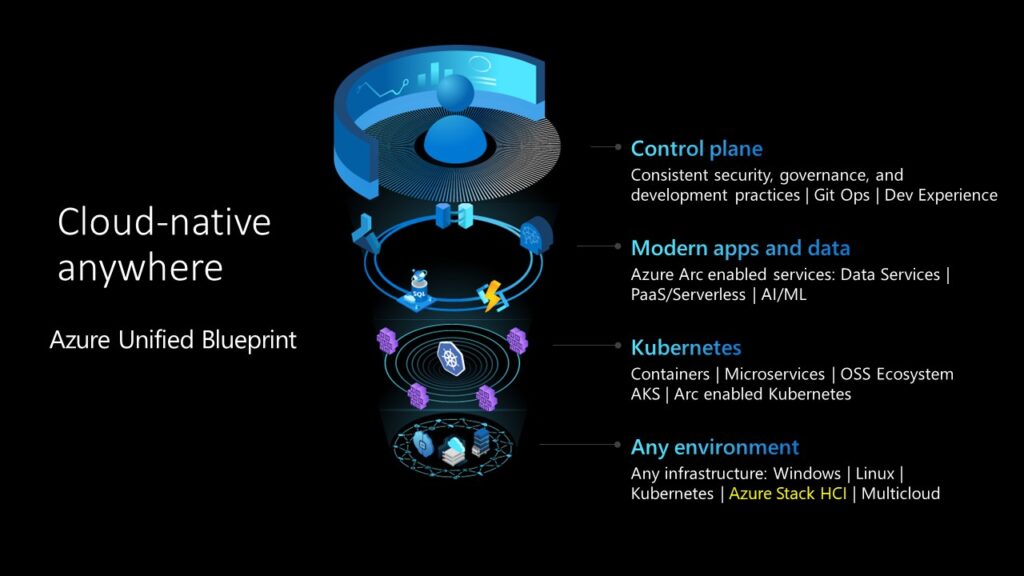
Over the last few years I have presented to hundreds of people on the topic of Azure Hybrid, doing my best to explain the Microsoft strategy around hybrid and multicloud. Whether I am presenting to customers, partners, colleagues, technical engineers or CxOs I always start by explaining the Azure Hybrid or now Azure Adaptive Cloud strategy and then provide an overview of Azure Stack HCI and Azure Arc and so I thought it might be useful to write a blog on each of these topics.
Microsoft Ignite 2024 is only a week away on November 18th and will bring lots of updates and inevitably an an evolution to this strategy so make sure you’re signed up!
I thought I would sum up where we have been so far on this journey prior to Ignite and bring Lisa at the Edge back post Ignite to discuss the new developments!
Make sure you check out the Arc Jumpstart YouTube channel to find out more about what’s happening in the world of Adaptive Cloud at Ignite!
The Current Landscape
First of all lets think about what organisations are doing when it comes to cloud adoption to better understand the moves Microsoft have been making specifically in the last 4-5 years.
In truth Microsoft have understood the need for hybrid cloud for a long time. I like to think that they differ from the likes of AWS and Google in this way as they grew up in the on-premises world and therefore have a good understanding of the complexities and requirements in this area.
But the last 4-5 years is where we have seen the development of Azure Arc and Azure Stack HCI and the evolution of the way in which specifically Microsoft view the world of hybrid and multicloud. Hybrid to Microsoft is not just: having workloads at the edge or in a datacentre and also workloads in the public cloud connected in some way. They have always viewed hybrid as a something which is designed specifically to provide an as consistent operating experience as possible whilst allowing for the needs of these two quite different operating environments.
According to IDC Enterprise Infra Tracker 93% of enterprises are committed to a hybrid cloud strategy and customers are still investing in and replacing their hardware. This is something I see daily in my day to day role. On top of this we have the impact of the edge with 75% of data created being created at the edge by 2025 according to Gartner.
These stats are not surprising when we consider that there are legit reasons as to why a workload may not be suitable or optimal for running in a cloud native environment. I say legit because I often see and hear fear mongering in this industry around why things should not move to the cloud, usually due to companies or individuals looking to protect their pay check rather than help the customer identify the right landing zone for their workloads and maximise the best of both worlds. Something which frustrates me greatly.
So, what are some legit reasons why a workload may not be best suited for the public cloud? I doubt that any of these will be surprising or new to you.
Regulatory and Data Sovereignty restrictions: these are pretty self explanatory and although Azure has over 100 compliance certifications and is perhaps the most secure public cloud platform, the fact remains that some workloads and data are subject to restrictions which mean that they cannot live in a Microsoft datacentre.
Latency: Although we live in a very connected world latency can still be a problem, and latency coupled with data regulations has the data gravity effect whereby workloads are pulled towards wherever the data needs to live.
Add to either of these workload interdependency and the fact there are still workloads out there which have complex legacy requirements and you have a list of legit reasons why they cannot move to a public cloud environment.
There are also workloads which require high performance, which can be costly in the public cloud, especially if these workloads need to run consistently.
Plus, as the stats show organizations have made and are still investing in their hardware estates, and understandably, want to get the most out of these assets.
As you can see, and were probably already aware, there are plenty of legit reasons that workloads may not be able to move to Azure and take advantage of all that cloud native innovation.
Adaptive Cloud Strategy
So what are Microsoft doing to address this hybrid/multicloud reality?
I’ll be honest, when I first saw the new Adaptive Cloud messaging, I rolled my eyes, which I am sure won’t surprise those that know me.
But why did I have this reaction? A few reasons…

First of all big tech marketing is really annoying me recently, all I see and hear are buzzwords. Buzzwords often not backed up by anything of value and very little technical detail and creates confusion.
Second of all we have so many different cloud buzz words already that I instantly thought, do we really need another one?
But then I took a deep breath, as I find myself doing more often than not these days, and I tried to understand the reasoning behind it. After speaking with Microsoft product management teams and my MVP buddies, I came to the conclusion that I actually like it. I’m not saying I am thrilled at yet another cloud term but hear me out.
Another thing which has frustrated me (are you getting a picture here?) is the fact that cloud terminology has focused on location. I’m sure almost all of us by now have heard the phrase ‘cloud is not a location it is an operating model‘ and whilst this might also incur some eye rolling it is actually correct, and has been over looked for years now as the war between on-premises and cloud (as a location) has raged on. The terms hybrid, multicloud, edge, distributed each have their own implications but focus heavily on location.
Then there is the term ‘Cloud First’. How many people have heard organisations say ‘we have a cloud first strategy’? And how often, when you dig in a little deeper, does this ultimately result in being a lift and shift strategy of workloads to a different location rather than actually adopting a cloud operating model? Then come the cloud adoption nightmares and the resulting drama around repatriation. But I won’t get on my soap box about that just now.
Anyway enough ranting.
So why do I like the term Adaptive Cloud?
Ultimately Microsoft understand that not all workloads can move to their datacentres and so they are working to make Azure adaptable to wherever their customers workloads need to live. Now ‘Cloud first’ no longer equates to a Microsoft datacentre because they are enabling workloads to take advantage of Azure services and capabilities wherever they need to run. Adaptive cloud brings the focus back to the cloud operating model and the goal is to make that operating model as consistent as possible across different environments.
So honestly, I like it!
Delivering on Adaptive Cloud Strategy
How are Microsoft delivering on this strategy?

First up Azure wants to extend their services and capabilities to any infrastructure. What does any infrastructure mean? In this case it means any virtual or physical machine or kubernetes clusters running on any platform anywhere. This could be a virtual Machine (VM) running on VMware vSphere or it could be a VM running in AWS. They do this via Azure Arc.
Azure Arc projects this infrastructure in to the Azure portal so that Azure governance, management and security constructs and services can be applied to infrastructure running outside of Azure. The aim here is to provide consistency across these different environments whilst allowing data and workloads to run where they need to.
Once a kubernetes cluster has been projected in to Azure it can also benefit from Azure governance, management and security services but importantly it can also become a deployment target for Azure cloud native services such as SQL Managed Instance.
And finally, with all workloads, regardless of where they live, visible, and depending on what workloads they are, manageable, from the Azure portal, more consistency can be gained in terms of security governance and management.
I have said consistency, governance, management and security a lot. I say these words multiple times a day, but this is really where the value lies the Adaptive Cloud approach and it is the area I see the most interest in from customers.
Summary
I looked up the Gartner definition of distributed cloud.
‘distribution of public cloud services to different physical locations’ while the operation, governance and evolution of the services are the responsibility of the originating public cloud provider.
And Gartner goes on to say the goal of this is to address complexity of hybrid cloud.

And as you can see Microsoft are the leaders in this new category of distributed cloud. I actually would have put them further ahead in terms of vision, what they are developing and looking to achieve with Azure Arc is leagues ahead of any other provider in terms of capability and reach. But maybe I am biased!
In the next instalment we will take a look at Azure Arc and I’ll do my best to provide an overview of what is actually quite a complex topic.
Hopefully you found this helpful or at least now know that you are not alone if you too are over the cloud buzzword bingo!
Let me know your thoughts on Adaptive Cloud!
